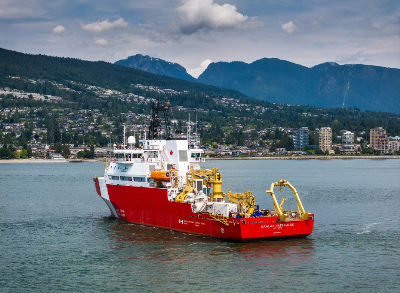
© https://canadiandefencereview.com
У Канаді розпочалися морські випробування нового науково-дослідного судна CCGS Naalak Nappaaluk, яке стане найбільшим науковим судном Канадської берегової охорони. Це судно класу Polar Class 6, довжиною 88 метрів і водотоннажністю 5058 тонн, здатне працювати в умовах льодовиків і забезпечить значну підтримку досліджень океанографії, геології та гідрографії на сході Канади. Судно розроблено для заміни старіючого CCGS Hudson і стане основним науковим судном Канадської берегової охорони на наступні 30 років. Назва судна, Naalak Nappaaluk, обрана на честь шанованого старійшини інуїтів з Кангиксуйвака, Квебек, який був відомий своєю відданістю збереженню та розвитку інуїтської культури і мови. Це рішення було ухвалене в співпраці з організацією Inuit Tapiriit Kanatami, що підкреслює важливість культурної інтеграції в наукові проекти Канади. Судно оснащене сучасним науковим обладнанням, включаючи сенсори для дослідження океанських течій та морського дна, а також постійними та переносними лабораторіями. Це дозволить проводити дослідження, спрямовані на вивчення впливу зміни клімату на океанські екосистеми. Завершення будівництва та офіційна передача судна Канадській береговій охороні очікується в серпні 2025 року. Цей проект є частиною Національної стратегії суднобудування Канади, спрямованої на оновлення флоту та підтримку інновацій у морській науці. Він також сприятиме розвитку суднобудівної промисловості та створенню нових робочих місць у країні.
Canada Launches Its Largest Oceanic Trials
In Canada, sea trials have begun for the new offshore oceanographic research vessel, CCGS Naalak Nappaaluk, which will become the largest scientific ship in the Canadian Coast Guard fleet. This Polar Class 6 vessel is 88 meters long and has a displacement of 5,058 tons. It is designed to operate in icy conditions and will provide significant support for oceanographic, geological, and hydrographic research on Canada’s east coast. The ship is built to replace the aging CCGS Hudson and will serve as the flagship scientific vessel for the Canadian Coast Guard for the next 30 years. The vessel’s name, Naalak Nappaaluk, honors a respected Inuit elder from Kangirsuk, Quebec, known for his dedication to preserving and promoting Inuit culture and language. This name was chosen in collaboration with Inuit Tapiriit Kanatami, highlighting the importance of cultural integration in Canada’s scientific projects. The vessel is equipped with state-of-the-art scientific equipment, including sensors to study ocean currents and the seafloor, as well as permanent and portable laboratories. This will enable research focused on understanding the impact of climate change on marine ecosystems. Construction completion and official delivery to the Canadian Coast Guard are expected in August 2025. This project is part of Canada’s National Shipbuilding Strategy, aimed at modernizing the fleet and supporting innovation in marine science. It will also contribute to the development of the shipbuilding industry and create new jobs across the country.
1117